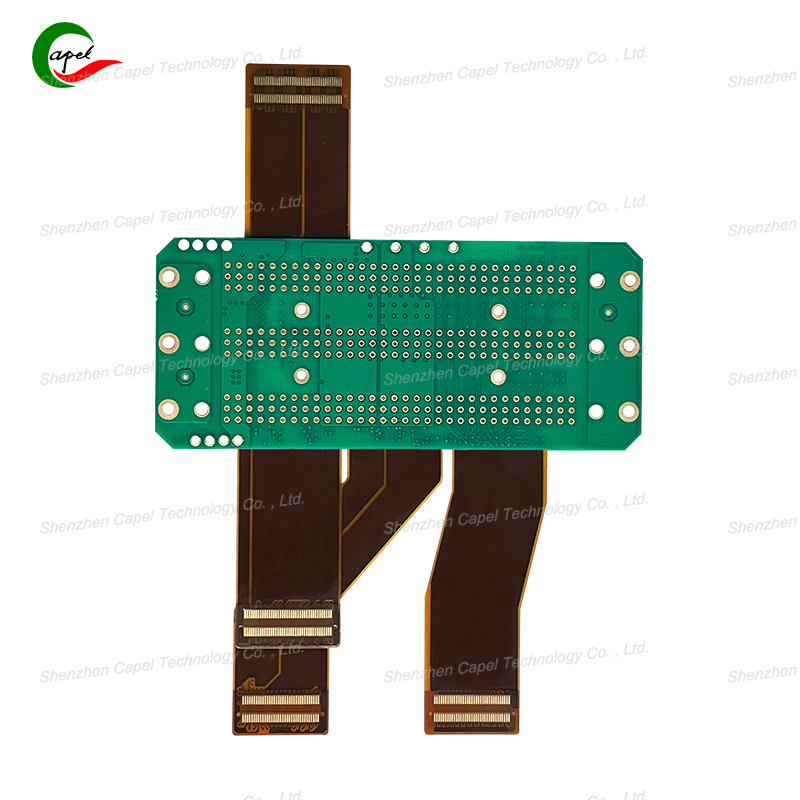Rigid-flex PCBs power foldable phones, medical sensors, and automotive radar—blending rigid layers for components and flexible layers for tight spaces. Their performance depends entirely on resin systems: the "glue" that binds substrates and defines traits like heat resistance, flexibility, and signal integrity. Choosing the wrong resin causes failures; the right one ensures reliability. Below is a concise breakdown of key resins, their traits, and use cases.
Rigid-flex substrates combine three parts:
-
Rigid layers: Glass-fiber (e.g., FR-4) + resin for stability.
-
Flexible layers: Polyimide (PI) film + resin for bending.
-
Adhesives: Resins bonding rigid/flexible sections.
Resins dictate critical performance:
-
Heat resistance: Can it survive 150°C in car engines?
-
Flexibility: Will it bend 100k+ times for foldables?
-
Signal integrity: Does it avoid EMI for 5G?
A wrong choice? A medical sensor might fail; a radar could misdetect obstacles.
Epoxies are the most used—affordable and easy to process.
-
Key Traits:
-
Cost: Low-moderate (50-70% cheaper than PI).
-
Heat resistance: Tg 120-180°C; max 130°C continuous use.
-
Flexibility: 1k-10k bends (limited).
-
Electrical: Dk 3.5-4.5 (1GHz) – good for consumer signals.
-
Best For:
-
Mid-range smartphones (rigid sections for chips).
-
Home appliances (washers, microwaves <100°C).
-
Limitations: Fails in high heat/ frequent bending.
Example: A phone brand uses epoxy in budget models—low cost fits production goals, and flexibility suffices for internal wiring.

PI is for extreme conditions—pricier but unbeatable for durability.
-
Key Traits:
-
Cost: High (2-3x epoxy).
-
Heat resistance: Tg 250-350°C; 200°C continuous use (300°C short bursts).
-
Flexibility: 100k+ bends (foldable-ready).
-
Electrical: Dk 3.0-3.8 (1GHz) – low loss for 5G.
-
Chemical/biocompatible: Safe for medical use.
-
Best For:
-
Foldables (Samsung Z Fold’s bending layers).
-
Medical catheters (sterilizable, biocompatible).
-
Aerospace (satellites’ temp swings).
-
Limitations: High curing temp (200-250°C) slows production.
Example: A medical firm uses PI in cardiac monitors—sterilizes at 134°C, no tissue reaction.
CE is for signal-critical designs—niche but essential for precision.
-
Key Traits:
-
Cost: Very high (3-4x epoxy).
-
Heat resistance: Tg 200-300°C; 180°C continuous use.
-
Flexibility: 5k-50k bends.
-
Electrical: Dk 2.8-3.2 (1GHz), Df 0.002-0.005 – minimal signal loss.
-
Best For:
-
5G base stations (24-40GHz signals).
-
Autonomous vehicle LiDAR (accurate obstacle detection).
-
Aerospace radar (high-frequency, extreme temps).
-
Limitations: Long cure time (4hrs @200°C) – slow production.
Example: A telecom uses CE in 5G towers—low loss keeps signals strong for urban coverage.
-
Map the Environment:
-
High heat (>180°C): PI/CE.
-
Frequent bending: PI.
-
Humid/chemicals: PI/CE.
-
Define Electrical Needs:
-
5G/radar (>10GHz): CE/PI.
-
Consumer signals (<10GHz): Epoxy.
-
Balance Cost:
-
Budget/volume: Epoxy.
-
Critical performance: PI/CE.
-
Mismatched Tg: Epoxy (130°C Tg) + PI (260°C Tg) delaminate—pair high-Tg epoxy (180°C) with mid-grade PI (200°C).
-
Over-Specifying: Using CE for a basic TV PCB wastes cost—epoxy works.
Resins are the backbone of rigid-flex PCBs. Epoxy for cost, PI for flexibility/heat, CE for high-frequency—match resin to environment, signals, and budget. The right choice doesn’t just build a PCB; it builds a reliable product.
Founded in 2009, our company has deep roots in the production of various circuit boards. We are dedicated to laying a solid electronic foundation and providing key support for the development of diverse industries.
Whether you are engaged in electronic manufacturing, smart device R&D, or any other field with circuit board needs, feel free to reach out to us via email at sales06@kbefpc.com. We look forward to addressing your inquiries, customizing solutions, and sincerely invite partners from all sectors to consult and collaborate, exploring new possibilities in the industry together.